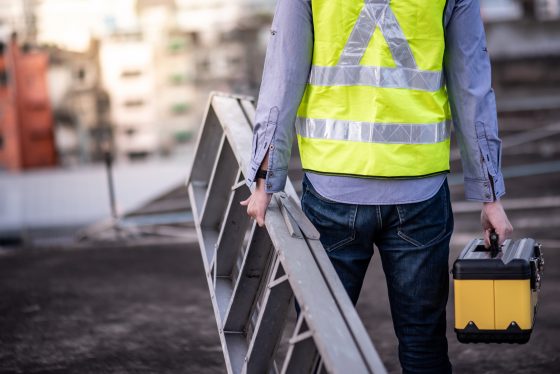Take a few minutes to ask some important questions before using a stepladder. It can help prevent falls and injuries.

Photo credit: istock.com/Zephyr18
I’ll never forget the time I saw a grocery store worker fall off a stepladder. It was a rainy day, and he was standing on the very top of the ladder (where you’re not supposed to stand) putting up a sheet of plastic to cover the produce bins outside the store. Suddenly, his feet slipped out from under him, and he landed on his back in a bin of onions.
Then, he quickly got up and climbed the very same ladder to resume his task. My son, who was with me at the time, said, “You should write a blog post about this!” (So, I went home and wrote How not to use a ladder.)
While the grocery store worker was lucky to avoid harm, injuries from falls can include sprains, bruises, fractures, concussions, and more. In 2021, WorkSafeBC accepted 4,050 claims related to injuries caused by falls from elevation.
Falls are usually caused by a combination of factors, including slippery surfaces, overexertion, and not following safe-work procedures. (See WorkSafeBC warns of the dangers from falls at work for more information.)
Preventing stepladder falls
From 2019 to 2021, the construction industry, for example, saw over 1,000 falls from ladders – 30 percent of which involved stepladders.
“These incidents often result from a lack of planning, training, or supervision,” says Jaret Swanson, manager of construction, OHS Consultation & Education Services, at WorkSafeBC. “Using ladders in construction is so routine that often no one questions whether a safer alternative is available, such as a scaffold or elevated work platform.”
Workers and employers should plan ahead to identify hazards, evaluate risks, and implement effective controls before using a ladder.
Here are some of the questions that Jaret advises we ask as part of a risk assessment before using ladders. The following apply in any industry:
- If you have to use a ladder, have you chosen the right type and inspected it to make sure it’s in good condition?
- How long will the task take? Stepladders are meant to be used for short-duration, light- performance work closer to the ground.
- What is the load or duty rating on the stepladder? Consider your weight and the weight of your tools.
- Will you need to carry something up and down the ladder?
- Do you have to reposition the stepladder multiple times to prevent overreaching?
- Do you plan to tie off the ladder and secure it each time you reposition? If that seems like a lot of effort, a work platform might be a safer alternative.
For safety resources on choosing, setting up, and working safely from ladders, visit the Ladders and Stepladders pages on worksafebc.com.
Please take care and be prepared before you or your workers reach for a stepladder.


